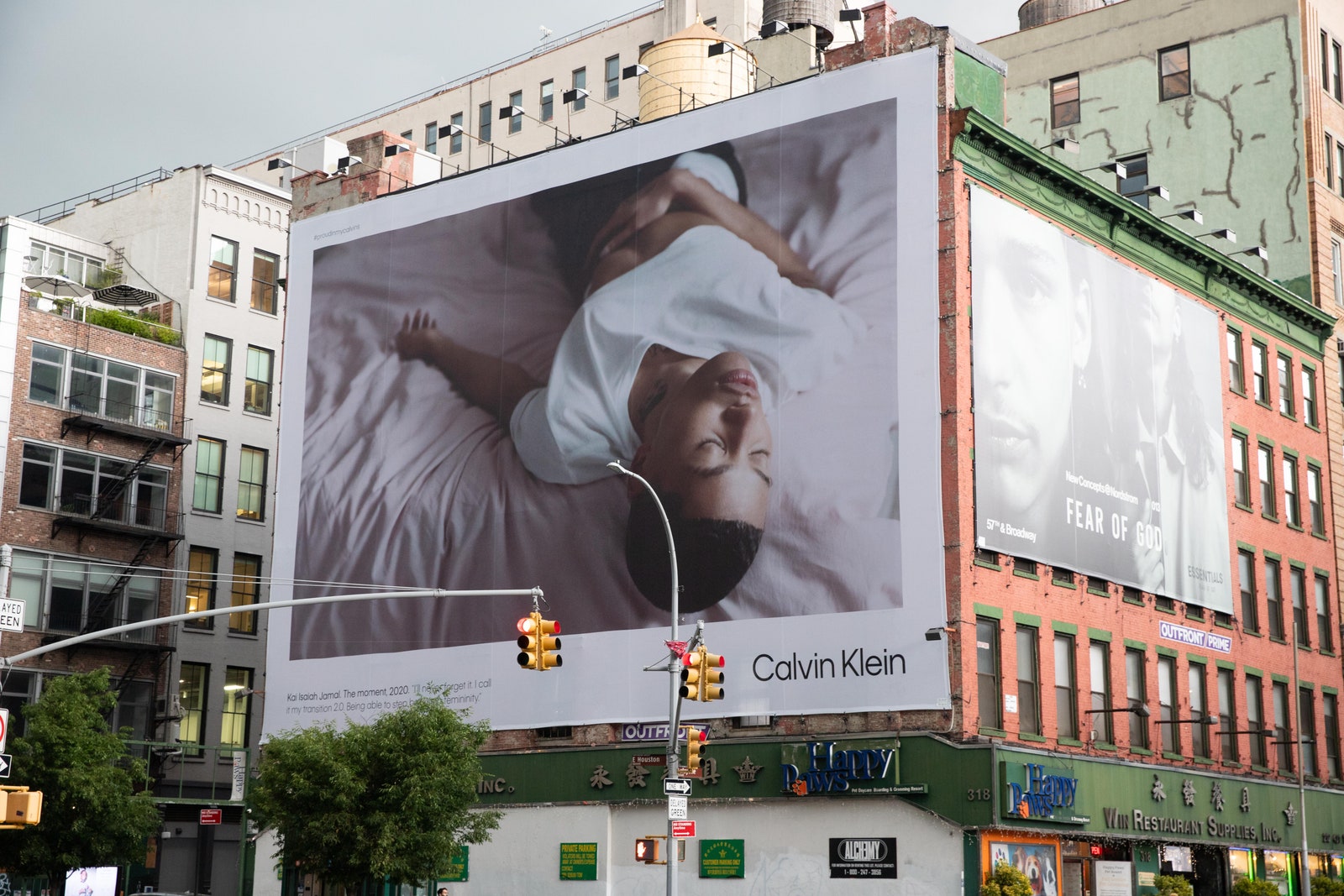Nothing about a physical billboard screams innovation. But over the past five years, Calvin Klein’s made the billboard a platform to broadcast firsts: the first gay couple, the first Black trans
woman in Jones, and as the first plus-size woman (the rapper Chika, featured in a campaign that purposefully echoed Kate Moss’s iconic CK photos).
The brand sees the billboard as a way to make a larger statement—one that may just so happen to translate to selling more of those undies. “It's really important to understand who our customer is, and understand from a cultural standpoint what's happening,” Peters, the Calvin Klein executive, says. There is really no better way for Calvin Klein to insert themselves into that conversation than the billboard. It is a 75-by-55 foot canvas for the brand to “show support for the things that matter to our customer,” Peters says.
This year's Pride campaign features poet and activist Kai-Isaiah Jamal…
Courtesy Calvin Klein…and singer King Princess.
The scale of the billboard means that it lands like a comet, causing tremors across the modeling industry. Jones reports that not only has she been getting more modeling offers, but that she’s seen an increase in Black trans models across important fashion campaigns. That’s no doubt been inspired in part by brands finally seeing the beauty (and profitability) in diversity in the wake of the Black Lives Matter movement, but Jones holds up her campaign as proof-positive that inclusivity doesn’t have to cut into the bottom line. “I feel like it was such a ripple effect, not only for my own career, but for a lot of Black trans women who have been trying to tap into this industry,” Jones says. “I want people to see that we can do it and see that it's a good business move as well.”
But over the years, the billboard has also been the center of controversy. In 2009, members of the American Family Association got all wound up by a campaign that featured a potential foursome. In 2016, a setup that described model Klara Kristin as a “seducer” and rapper Fetty Wap as a “money maker” led to accusations of sexism. As far as Kristin was concerned, the response meant mission accomplished. “What I remember the most is the media hysteria where I found myself in the middle of a sexism debate, which I did not expect at all,” Kristin says now. “To see a debate on Fox News about a photo of me was pretty strange. I guess the campaign did its job.” Peters understands how previous campaigns can seem purposefully provocative, but thinks of the billboard's role a little differently. The magnitude of the billboard means it can “challenge the status quo,” Peters says, “and I feel like anytime you do that as a brand, it might be labeled as provocation.”
Provocateur, boundary pusher, star-maker, mammoth canvas—whatever you call the billboard, the sum of its parts is what makes it one of New York’s most enduring landmarks. “Of course the most famous thing about SoHo is Houston Street, and I believe that the most significant landmark of Houston Street is the Calvin Klein billboard,” says Ronnie Fieg, the founder of Kith. “It serves as a beacon to people to let them know they have officially entered SoHo. As a native New Yorker, that billboard has been ingrained in my life for as long as I can remember. Whether you’ve been here or not, you’ve seen it in a movie or a show or a magazine. That significance still rings true to me.” Fieg’s flagship store is just down the street; Kith collaborated with Calvin Klein on a collection and campaign that went up on the billboard last September.
This 2009 billboard drew the wrath of the American Family Association.
Chris Hondros/Getty ImagesThe billboard’s success is a testament to the power of endurance in a city where constant changeover is the standard. The SoHo fixture has been around long enough to become nostalgic—and, more practically, a landmark to navigate the neighborhood. “When people ask our location, we usually give our address and if customers are still confused, oftentimes we say, ‘That building with the Calvin Klein ads,’” says Helen Chiu, an executive with Win Restaurant Supply, the business that occupies the building directly underneath the billboard. “It is nice to be associated with the Calvin Klein billboard.”
A place like New York isn’t exactly lacking for landmarks. Still, Calvin Klein has managed to carve out its spot in the city—a tourist attraction in the heart of downtown New York. “That's our Times Square,” designer Heron Preston says. “I moved here in 2004, skating down Houston Street, dodging traffic. It really just has this location and it has this presence on the street. That Calvin Klein billboard is the billboard of New York.”

